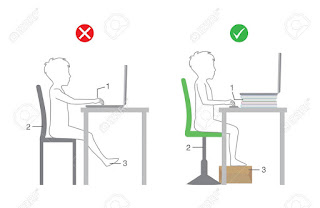POSTURE OF GROWING KIDS
Most postural problems start from childhood / adolescence, when the body is developing. Poor posture can result in pain or disability. Good posture in childhood ensures good habits in adult life.Good posture
Posture is the positioning of the parts of the body when standing, sitting or lying down.Good posture is the state of balance between muscles and joints which protects the body against injury. This puts the least amount of strain your back.
Good posture :
- The spine keeps its natural ‘S’ curve ,
- Bones and joints are aligned so that muscles can be used efficiently
- Ligaments supporting the spine are not strained
- Your body doesn’t tire as easily
- You don’t get back pain
- You look good!
Therefore to get a good posture you need to:
- Have strong stabilization muscles (e.g. core)
- Have flexible muscles
- Have a balance between muscles on each side of the spine
- Have good joint mobility
- Be aware of your posture and work on it
Regular exercise such as running, swimming or playing different sports will help keep the muscles strong.
There are many causes of incorrect posture in children. Nowadays factors such as;
There are many causes of incorrect posture in children. Nowadays factors such as;
- prolonged sitting in front of the TV or playing games on the tablet or cell phone play a major role in poor posture.
- Heavy schoolbags are another weighty problem.
- Other causes include poor seating, beds or desks;
- diseases and disabilities;
- obesity and self esteem.
Children spend increasingly more time in a seated position, in the classroom and at home in front of the TV or computer. Maintaining a sitting position for a long time causes asymmetries of the body. The normal lumbar curve decreases and the thoracic spine slouches.
Children should follow these guidelines to improve sitting posture.
|
Sitting correctly when working on a computer is also important:
- Don’t lean forward, sit with your back up straight against the backrest of the chair.
- Move the chair close to the keyboard so that your arms can rest on the desk. Keep your shoulders relaxed.
- Your eyes should be level with the top of the screen.
- You should move around every 30 minutes to let your body relax
About school bags;
The weight of children’s schoolbags and consequences of such heavy loads on the developing spine is an ongoing concern.A general guideline for acceptable weight of scholars’ backpacks is 10% of body weight. In a recent study conducted in Ireland, results show that most scholars’ backpacks weigh more than 10% body weight. This may lead to pain and discomfort of the neck, shoulders or back in the short term and imbalances in postural alignment and damage to the neural structures in the long term.
Heavy backpacks carried on one shoulder cause the spine to compress on one side and puts stress on the muscles, ligaments and discs of the spine. Children mostly bend forward when schoolbags are too heavy - Hinging forward at the hips and causing a forward head posture. This changes the natural ‘S’ curve of the spine.

Preventing the side effects of heavy schoolbags is vital. Below are some tips.
|  |
The wheelie bag;
May be a good choice but it has its own set of problems. It causes rotation of the upper body when pulling the bag. It is therefore recommended to roll the bag next to the body or push it in front of the body.
Precaution is better than cure
. It has been found that preventative postural exercises have the best long term prognosis. that postural education in schools and by parents at home should be encouraged to improve health and prevent injuries related to the spine. If your child does complain of back ache or neck pain due to poor posture, assessment and treatment by a physiotherapist will help to identify the problem, and restore and preserve good body mechanics. Exercises to strengthen weak muscles and stretch tight muscles help to achieve this muscle balance.









